
Roy Rogers, nicknamed the King of the Cowboys, was an American singer, actor, television host, and rodeo performer.
The Sons of the Pioneers are one of the United States' earliest Western singing groups. Known for their vocal performances, their musicianship, and their songwriting, they produced innovative recordings that have inspired many Western music performers and remained popular through the years. Since 1933, through many changes in membership, the Sons of the Pioneers have remained one of the longest-surviving country music vocal groups.

Dale Evans Rogers was an American actress, singer, and songwriter. She was the second wife of singing cowboy film star Roy Rogers.

George Francis "Gabby" Hayes was an American actor. He began as something of a leading man and a character player, but he was best known for his numerous appearances in B-Western film series as the bewhiskered, cantankerous, but ever-loyal and brave comic sidekick of the cowboy stars Roy Rogers and John Wayne.

Trigger was a 15.3 hands palomino horse made famous in American Western films with his owner and rider, cowboy star Roy Rogers.
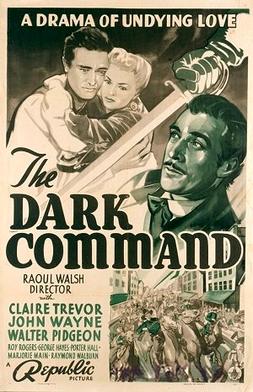
Dark Command is a 1940 Crime western film starring Claire Trevor, John Wayne and Walter Pidgeon loosely based on Quantrill's Raiders during the American Civil War. Directed by Raoul Walsh from the novel by W. R. Burnett, Dark Command is the only film in which western icons John Wayne and Roy Rogers appear together, and was the only film Wayne and Raoul Walsh made together since Walsh discovered Wayne working as a prop mover, renamed him, and gave him his first leading role in the epic widescreen Western The Big Trail a decade before.

Broken Trail is a 2006 Western television miniseries directed by Walter Hill and starring Robert Duvall and Thomas Haden Church. Written by Alan Geoffrion, who also wrote the novel, the story is about an aging cowboy and his nephew who transport 500 horses from Oregon to Wyoming to sell them to the British Army. Along the way, their simple horse drive is complicated when they rescue five Chinese girls from a slave trader, saving them from a life of prostitution and indentured servitude. Compelled to do the right thing, they take the girls with them as they continue their perilous trek across the frontier, followed by a vicious gang of killers sent by the whorehouse madam who originally paid for the girls.

The Roy Rogers Show is an American Western television series starring Roy Rogers. 100 episodes were broadcast on NBC for six seasons between December 30, 1951, and June 9, 1957. The episodes were set in the prevailing times (1950s) in the style of a neo-Western, rather than the Old West. Various episodes are known to be in the public domain today, being featured in low-budget cable television channels and home video.

In Old Santa Fe is a 1934 American Western film directed by David Howard, starring Ken Maynard, George "Gabby" Hayes and Evalyn Knapp and featuring the first screen appearance of Gene Autry, singing a bluegrass rendition of "Wyoming Waltz" accompanied by his own acoustic guitar with Smiley Burnette on accordion. Autry and Burnette were uncredited, but the scene served as a screen test for the duo for subsequent singing cowboy films, beginning with The Phantom Empire (1935), in which Autry had his first leading role.

Roy Barcroft was an American character actor famous for playing villains in B-Westerns and other genres. From 1937 to 1957, he appeared in more than 300 films for Republic Pictures. Film critic Leonard Maltin acclaimed Barcroft as "Republic Pictures' number one bad guy".
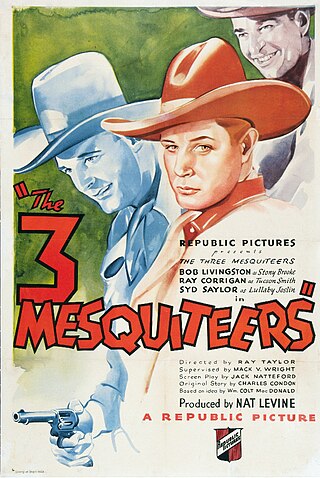
The Three Mesquiteers is the umbrella title for a Republic Pictures series of 51 American Western B-movies released between 1936 and 1943. The films, featuring a trio of Old West adventurers, was based on a series of Western novels by William Colt MacDonald. The eponymous trio, with occasional variations, were called Stony Brooke, Tucson Smith and Lullaby Joslin. John Wayne, who played Stony Brooke in eight of the films in 1938 and 1939, was the best-known actor in the series. Other leads included Bob Livingston, Ray "Crash" Corrigan, Max Terhune, Bob Steele, Rufe Davis and Tom Tyler.
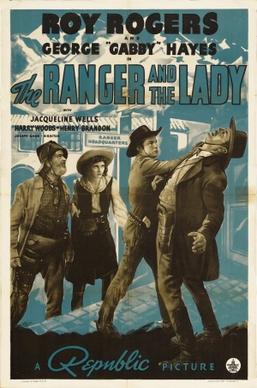
The Ranger and the Lady is a 1940 American Western film directed by Joseph Kane and starring Roy Rogers, and George "Gabby" Hayes.
Heart of the Golden West is a 1942 American Western film starring Roy Rogers.

Bells of Rosarita is a 1945 American musical Western film starring Roy Rogers and directed by Frank McDonald.
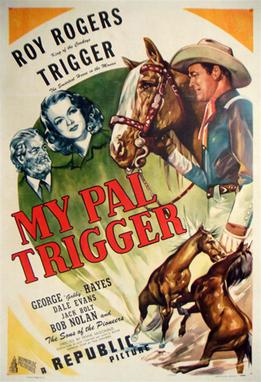
My Pal Trigger is a 1946 American Western musical film directed by Frank McDonald. The screenplay by Jack Townley and John K. Butler was based upon a story by Paul Gangelin. The film stars Roy Rogers, Dale Evans, George “Gabby” Hayes, Jack Holt, and Trigger in a story about the origin of Rogers' mount, and their deep and faithful bond. The film features several musical numbers for Rogers, Evans, and Bob Nolan and the Sons of the Pioneers.
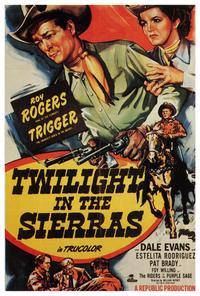
Twilight in the Sierras is a 1950 American Trucolor Western film directed by William Witney and starring Roy Rogers and his horse Trigger, along with Dale Evans, Estelita Rodriguez, and Pat Brady.

Estelita Rodriguez was a Cuban actress best known for her roles in many Westerns with Roy Rogers for Republic Pictures, as well as her role in Howard Hawks' Rio Bravo.
Frank BurgessMcDonald was an American film and television director, active from 1935 to 1966. He directed more than 100 films, including many Westerns starring Gene Autry and Roy Rogers, and numerous TV show episodes. He is interred at Conejo Mountain Memorial Park in Camarillo, California.

Don't Fence Me In is a 1945 American black-and-white Western film directed by John English and starring the "King of the Cowboys" Roy Rogers and his palomino Trigger, promoted in the production's opening credits and on theater posters as "The Smartest Horse in the Movies". Also featured in the film are Roy's sidekick George "Gabby" Hayes and Rogers' future wife Dale Evans. Produced and distributed by Republic Pictures, Don't Fence Me In is part of a long-running series of singing-cowboy films released by that company to showcase Rogers' musical talents and equestrian skills, as well as Trigger's abilities at performing impressive stunts and tricks.

Ted Mapes was an American character actor, who was also a prolific stuntman and body double. Born on November 25, 1901, in St. Edward, Nebraska, he moved to Los Angeles in his mid-20s, and entered the film industry in 1929, first as a grip, and then as a stuntman and actor. He doubled for many famous actors, including Jimmy Stewart and Gary Cooper. His film and television career spanned forty years, during which time he appeared in hundreds of films and television shows, either as an actor, stuntman or body double. After his career in front of the camera ended in 1969, Mapes became an advocate for animal safety in films, working as an observer on sets for the American Humane Association.

















